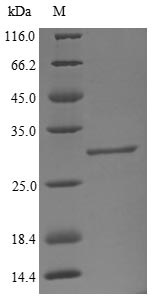Recombinant bovine Beta-1,4-galactosyltransferase 1 (B4GALT1) expression is initiated by transfecting yeast cells with a DNA expression vector containing the gene encoding the B4GALT1 protein (1-24aa) along with the N-terminal GST-tag gene. The subsequent culturing of the cells induces the expression of the desired protein. The resulting recombinant bovine B4GALT1 protein is collected and purified from the cell lysate through affinity purification, demonstrating a purity greater than 90%, as indicated by SDS-PAGE.
B4GALT1 plays a significant role in mammalian lactation, fertilization, protein glycosylation, and developmental processes [1]. B4GALT1 is a type II membrane-bound glycoprotein that transfers UDP-galactose to different acceptor sugar molecules, influencing the interaction and adhesion of immune cells and modifying N-acetylglucosamine residues of surface molecules [2]. The gene B4GALT1 generates two types of protein isoforms, long and short, and its high expression has been associated with poor prognosis in acute myeloid leukemia [3][4]. Furthermore, B4GALT1 has been linked to cancer cell growth, migration, and drug resistance in various types of cancer, such as colon cancer, osteosarcoma, non-small cell lung cancer, and chronic myelogenous leukemia [5][6][7][8]. In addition, B4GALT1 has been found to regulate apoptosis and autophagy in glioblastoma [9]. From a structural perspective, B4GALT1 possesses a type II membrane protein topology and a globular catalytic domain responsible for sugar transfer activity [10]. Moreover, the formation of B4GALT1 homomers serves to keep the enzyme minimally active until it reaches the Golgi compartment, where it binds to ST6GAL1 and exposes its active site [11]. Studies have also indicated that B4GALT1 mutations lead to reduced cholesterol ester transfer protein glycosylation and activity [12].
References:
[1] E. Landers, H. Burkin, G. Bleck, L. Skalla, & D. Miller, Porcine β1,4‐galactosyltransferase‐i sequence and expression, Reproduction in Domestic Animals, vol. 44, no. 2, p. 228-234, 2009. https://doi.org/10.1111/j.1439-0531.2007.01039.x
[2] V. Nilius, M. Killer, N. Timmesfeld, M. Schmitt, R. Moll, A. Lorchet al., High β-1,4-galactosyltransferase-i expression in peripheral t-lymphocytes is associated with a low risk of relapse in germ-cell cancer patients receiving high-dose chemotherapy with autologous stem cell reinfusion, Oncoimmunology, vol. 7, no. 5, p. e1423169, 2018. https://doi.org/10.1080/2162402x.2017.1423169
[3] M. Al‐Obaide, H. Alobydi, A. Abdel‐Salam, R. Zhang, & K. Srivenugopal, Multifaceted roles of 5′-regulatory region of the cancer associated gene b4galt1 and its comparison with the gene family, International Journal of Oncology, vol. 47, no. 4, p. 1393-1404, 2015. https://doi.org/10.3892/ijo.2015.3136
[4] Z. Ren, X. Huang, Q. Lv, Y. Lei, H. Shi, F. Wanget al., High expression of b4galt1 is associated with poor prognosis in acute myeloid leukemia, Frontiers in Genetics, vol. 13, 2022. https://doi.org/10.3389/fgene.2022.882004
[5] Y. Zhang, Z. Fang, X. Guo, H. Dong, K. Zhou, Z. Huanget al., Lncrna b4galt1‐as1 promotes colon cancer cell stemness and migration by recruiting yap to the nucleus and enhancing yap transcriptional activity, Journal of Cellular Physiology, vol. 234, no. 10, p. 18524-18534, 2019. https://doi.org/10.1002/jcp.28489
[6] Z. Li, Y. Wang, R. Hu, R. Xu, & W. Xu, Lncrna b4galt1‐as1 recruits hur to promote osteosarcoma cells stemness and migration via enhancing yap transcriptional activity, Cell Proliferation, vol. 51, no. 6, 2018. https://doi.org/10.1111/cpr.12504
[7] J. Lin, F. Chen, C. Wu, S. Hu, & J. Ma, Long non‑coding rna b4galt1‑antisense rna 1/microrna‑30e/sry‑box transcription factor 9 signaling axis contributes to non‑small cell lung cancer cell growth, Oncology Letters, vol. 20, no. 6, p. 1-1, 2020. https://doi.org/10.3892/ol.2020.12146
[8] Y. Liu, L. Wang, W. Liu, H. Zhang, J. Xue, Z. Zhanget al., Mir-124-3p/b4galt1 axis plays an important role in socs3-regulated growth and chemo-sensitivity of cml, Journal of Hematology & Oncology, vol. 9, no. 1, 2016. https://doi.org/10.1186/s13045-016-0300-3
[9] P. Wang, X. Li, & Y. Xie, B4galt1 regulates apoptosis and autophagy of glioblastoma in vitro and in vivo, Technology in Cancer Research & Treatment, vol. 19, p. 153303382098010, 2020. https://doi.org/10.1177/1533033820980104
[10] D. Harrus, F. Khoder-Agha, M. Peltoniemi, A. Hassinen, L. Ruddock, S. Kellokumpuet al., The dimeric structure of wild-type human glycosyltransferase b4galt1, Plos One, vol. 13, no. 10, p. e0205571, 2018. https://doi.org/10.1371/journal.pone.0205571
[11] F. Khoder-Agha, D. Harrus, G. Brysbaert, M. Lensink, A. Harduin-Lepers, T. Glumoffet al., Assembly of b4galt1/st6gal1 heteromers in the golgi membranes involves lateral interactions via highly charged surface domains, Journal of Biological Chemistry, vol. 294, no. 39, p. 14383-14393, 2019. https://doi.org/10.1074/jbc.ra119.009539
[12] M. Boogert, C. Crunelle, L. Ali, L. Larsen, S. Kuil, J. Levelset al., Reduced cetp glycosylation and activity in patients with homozygous b4galt1 mutations, Journal of Inherited Metabolic Disease, vol. 43, no. 3, p. 611-617, 2019. https://doi.org/10.1002/jimd.12200






